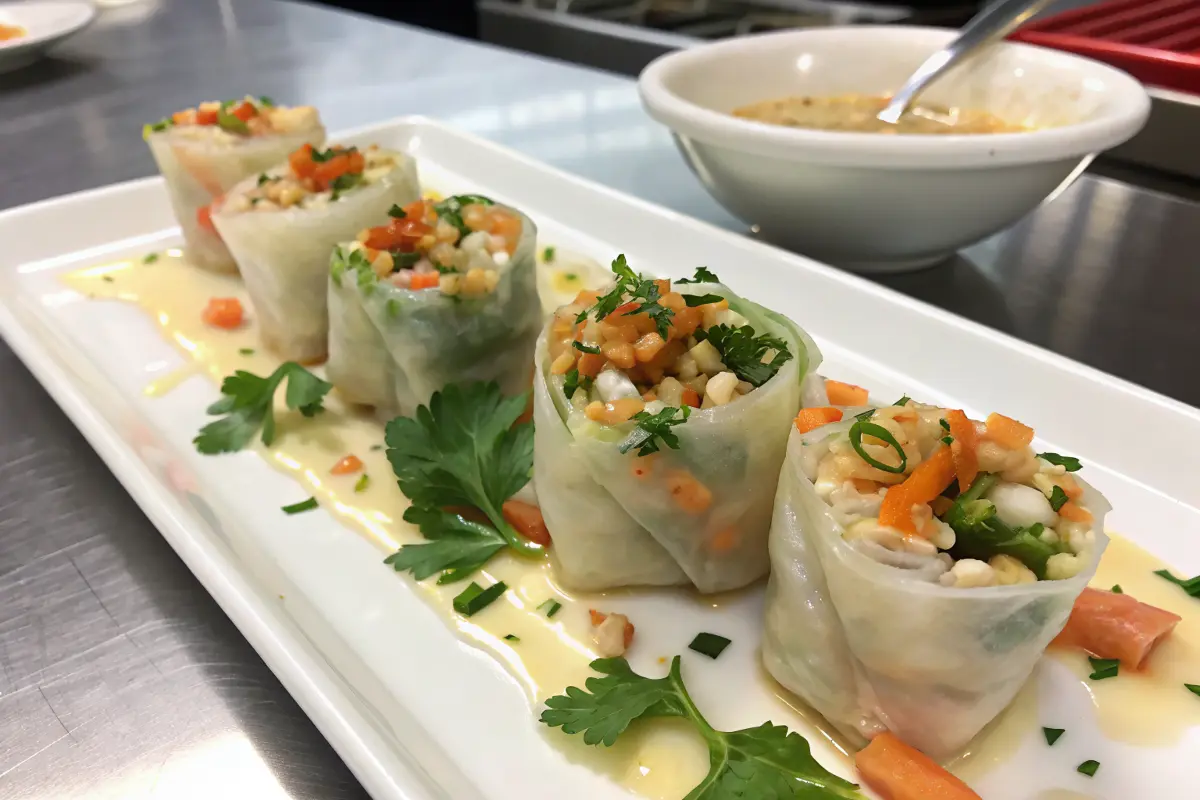Why rice paper dumplings?
Imagine a dumpling with a golden, delicate shell that shatters on first bite and gives way to juicy, well-seasoned filling — that’s the appeal of rice paper dumplings. They combine the portability and textural contrasts of rolls with the neat, snackable form of dumplings. Because rice paper is so versatile, you can steam, pan-fry, air-fry or bake these parcels and match them to many global flavor profiles.
If you want the classic advice on hydrating and handling rice paper, Andrea Nguyen’s practical tips are an excellent starting point. For the viral crispy approach — the dumpling press and frying technique that’s been all over social feeds — Marion’s Kitchen shows a creative, tested method. And for a straightforward pan-sear / air-fry recipe that captures the TikTok craze, I Heart Umami lays out a reproducible approach you can follow at home.
What are rice paper dumplings?
- They’re dumplings wrapped in edible rice paper (often called bánh tráng or rice wrappers) rather than wheat wrappers.
- They can be crisped (pan-fried or air-fried) or soft/steamed depending on the outcome you want.
- Fillings range from traditional pork/shrimp blends to vegetarian tofu-mushroom or glass-noodle mixes. Practical how-to guides and modern recipe variations are plentiful online.
Tools & pantry basics
You don’t need an arsenal to start, but a few items make the process easier:
- Rice paper rounds or sheets (22–24 cm rounds are versatile).
- Shallow bowls for warm water or a spray bottle for controlled moistening.
- Nonstick skillet or cast iron for pan-frying.
- Air fryer (optional) — great for batch crisping.
- Steamer basket (for soft/steamed dumplings).
- Dumpling press or mold (optional but speeds folding and ensures consistency — used in many viral crispy recipes).
- Small spatula/tongs, damp towel, and parchment or tray for assembled dumplings.
Ingredient for Rice Paper Dumplings
Filling (customizable):
- 1 cup finely shredded cabbage
- 1 medium carrot, shredded
- ½ cup mushrooms, finely chopped
- 2 green onions, finely sliced
- 1 clove garlic, minced
- 1 tsp fresh ginger, grated
- 1 tbsp soy sauce (or tamari for gluten-free)
- 1 tsp sesame oil
- ½ cup protein of choice (crumbled tofu, ground chicken, shrimp, or tempeh – optional)
Wrappers:
- 10–12 sheets rice paper (round, 8–9 inch size)
For cooking:
- 2–3 tbsp neutral oil (vegetable, avocado, or sesame blend)
Dipping Sauce:
- 3 tbsp soy sauce
- 1 tbsp rice vinegar
- ½ tsp sesame oil
- ½ tsp chili flakes or sriracha
- ½ tsp honey or sugar (optional for sweetness)
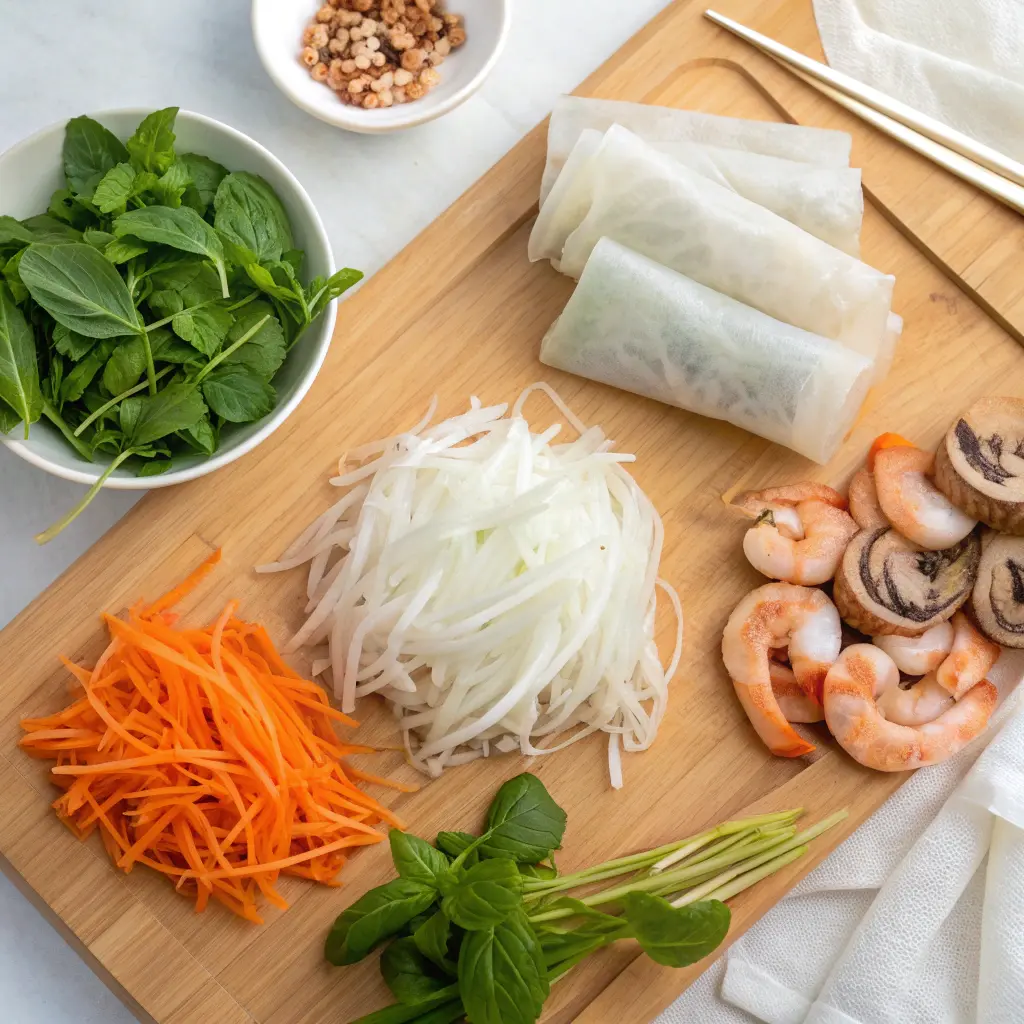
Instructions
- Make the filling
- Heat a skillet with a little oil.
- Sauté garlic and ginger until fragrant.
- Add cabbage, carrots, mushrooms (and protein if using). Cook 3–4 minutes.
- Stir in soy sauce and sesame oil. Remove from heat and let cool slightly.
- Prepare rice paper
- Fill a shallow dish with warm water.
- Dip a rice paper sheet for 5–7 seconds until pliable (don’t over-soak).
- For sturdier dumplings, use 2 sheets stacked together.
- Assemble dumplings
- Place softened rice paper on a clean surface.
- Add ~2 tbsp filling in the center.
- Fold sides over, then roll tightly into a dumpling pocket.
- Cook
- Heat oil in a nonstick skillet over medium heat.
- Place dumplings seam-side down. Cook 2–3 minutes per side until golden and crispy.
- Optionally cover with a lid for a minute to steam inside.
- Serve
- Enjoy hot with dipping sauce.
Mastering rice paper: softening & handling without tears
This is the single-most important skill. The wrong hydration and you’ll have sticky, saggy or torn wrappers — and nothing is more frustrating mid-roll.
Two proven approaches:
- Quick dunk (recommended for most cooks)
- Fill a shallow bowl with warm water (not boiling).
- Dip the rice paper fully for 1–3 seconds, then lift and lay flat on your work surface. The center should be pliable; edges slightly firmer. Work quickly. Rice paper softens in seconds — don’t soak. Andrea Nguyen and other pros recommend a fast dunk rather than a long soak because standing water will over-hydrate the sheet.
- Wipe / spray method (control method for delicate sheets)
- Lay the dry sheet on a damp towel and gently spray or brush the surface with warm water.
- This gives you control and reduces the risk of over-saturating the edges.
Key cues: the wrapper should bend easily but still hold some tackiness; if it’s limp and opaque, it’s too wet. If the wrapper is still chalky and brittle, it needs a fraction more water.
Folding & shaping: three techniques
Here are three reliable folds — choose one by texture and appearance you want.
A. Purse fold (best for crispy parcel dumplings)
- Lay hydrated round flat. Spoon filling in center.
- Bring edges up like a purse and twist or pinch to seal.
- For extra security, overlap a second thin strip of rice paper or a small dab of water at the seam.
B. Classic pleated dumpling (for steamed/soft dumplings)
- Place filling in a semi-circle near the edge.
- Fold into a half-moon, pleating the top edge with small tucks, sealing with a light water dab.
- This gives a more dumpling-like look and steams beautifully.
C. Dumpling press / mold method (fast + uniform)
- Use a small dumpling press: center the hydrated sheet on the mold, add filling, fold and press to seal per tool instructions.
- Marion’s Kitchen demonstrates an elegant way to use a press to make consistent crispy dumplings — perfect if you’re making a crowd-pleasing batch. Marion’s Kitchen
Pro tip: work on a slightly damp towel to prevent tearing during transfer.
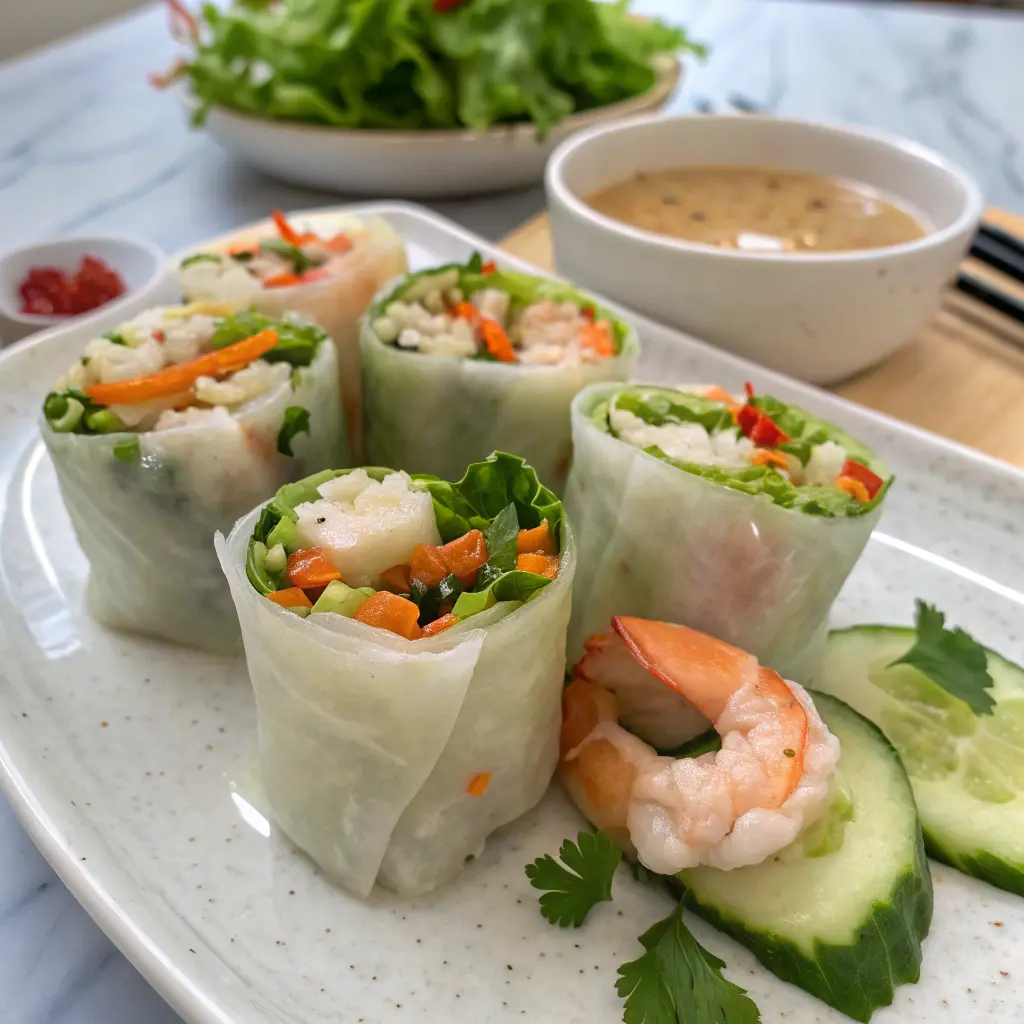
Cooking methods & timing
Choose the finish based on desired texture.
1) Pan-fry (shallow)
- Heat 2–3 tbsp neutral oil in a nonstick skillet over medium-high heat.
- Place dumplings seam-side down, cook until golden (2–4 minutes), flip and crisp the other side (1–2 minutes).
- For extra crisp, reduce heat and press gently with spatula to promote even contact.
2) Air-fry (batch crisping)
- Preheat air fryer to 180–190°C (350–375°F).
- Lightly brush dumplings with oil and air-fry 8–12 minutes, flipping once, until golden. This method is reliable for consistent batches.
3) Steam (soft)
- Arrange dumplings in a single layer in a steamer lined with parchment or cabbage leaves.
- Steam 6–10 minutes depending on size and filling, until filling is cooked through.
4) Bake (oven crisp)
- Brush with oil and bake at 200°C (400°F) for 12–20 minutes, turning halfway. Finish with a quick broil if you want ultra-crisp edges.
For crisp outsides with tender insides, a hybrid method works well: steam briefly to heat through, then pan-fry quickly to crisp.
Sauces that sing with rice paper dumplings
Pair your dumplings with 1–3 dipping sauces for a variety of flavor notes.
- Nuoc Cham (classic Vietnamese dip)
- Fish sauce, lime, sugar, water, thinly sliced chili and garlic; adjust balance to taste. (Vibrant with shrimp/pork fillings.)
- Hoisin-sesame dip
- Hoisin + a dash of soy, sesame oil, rice vinegar; garnish with chopped peanuts or sesame seeds.
- Spicy soy-vinegar
- Soy sauce, rice vinegar, a drizzle of chili oil, and finely sliced scallions.
Match lighter herbaceous fillings with the tangy nuoc cham and richer meat fillings with hoisin or chili oil blends.
Variations & fusion ideas
- Korean-inspired: brush gochujang glaze over crispy dumplings and top with scallion and sesame.
- Japanese-inspired: serve with ponzu and yuzu kosho for a citrusy heat.
- Dessert parcels: fill with sweet red bean paste, banana-mango jam or chocolate + toasted coconut; dust with powdered sugar post-fry.
- Regional greens: fold in shredded kimchi for a spicy, funky filling (drain well to avoid sogginess).
Make-ahead, freezing & storage
- Freezing raw: freeze assembled dumplings flat on a tray until firm, then transfer to bags. Cook from frozen — add a few minutes to cooking time.
- Freezing cooked: flash-cool cooked dumplings, freeze on tray, then bag. Reheat in oven or air fryer to restore crispness.
- Short-term fridge: keep raw assembled dumplings up to 24 hours (best made same day). Cooked dumplings last 2–3 days refrigerated.
Troubleshooting common problems
- Wrapper tearing: usually from over-soaking or rough handling. Use quick dunk method and a gentle touch.
- Soggy dumplings: filling too wet. Sauté vegetables to release moisture and drain well; add cornstarch binder.
- Fillings falling out: under-sealed seam. Use a dab of water or a thin strip of extra hydrated rice paper to reinforce seams.
- Uneven crisping: oil not hot enough or overcrowded pan. Give each dumpling space and moderate the heat.
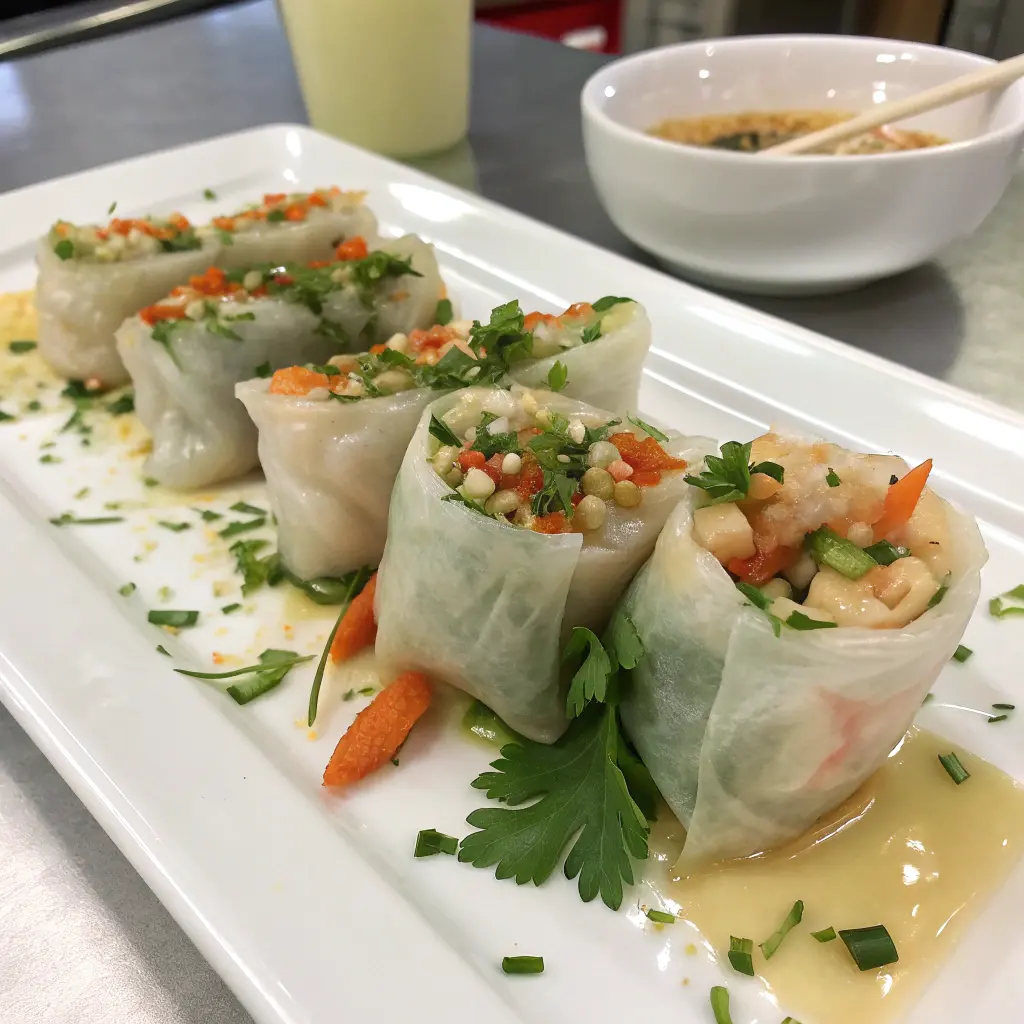
FAQ (People Also Ask style)
Q: What are rice paper dumplings?
A: Dumplings wrapped in edible rice paper — they can be steamed, pan-fried, air-fried or baked, and typically hold fillings like pork, shrimp, tofu or vegetables.
Q: How do you stop rice paper from tearing?
A: Hydrate briefly (quick dunk in warm water) and work on a damp surface; do not soak. Use gentle folding and avoid overfilling.
Q: Can you freeze rice paper dumplings?
A: Yes — flash-freeze assembled dumplings on a tray, then transfer to freezer bags. Cook from frozen, increasing time slightly.
Q: Are rice paper dumplings crispy or soft?
A: They can be either. Crispy results come from pan-frying or air-frying; soft from steaming. Some cooks use a hybrid steam-then-pan technique.
Q: How do you reheat crispy dumplings?
A: Use an air fryer or oven to reheat so the exterior re-crisp without turning gummy.
Conclusion
You’ve now got everything you need to make show-stopping rice paper dumplings at home — from rice paper hydration and three dependable filling templates to crisping and steaming techniques, saucing ideas, and troubleshooting tips. Master the quick-dunk trick, keep fillings moist but not wet, and choose the folding method that fits the texture you want — purse for crispy parcels or pleated for classic dumplings.
Print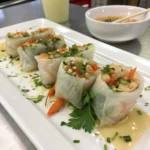
Irresistible Rice Paper Dumplings Recipe
- Total Time: PT30M
- Yield: 12 dumplings 1x
- Diet: Vegan
Description
These Rice Paper Dumplings are crispy on the outside and packed with a savory veggie filling inside. Inspired by Vietnamese-style street food, they’re pan-fried to perfection and make a delicious appetizer, snack, or light meal.
Ingredients
Filling (customizable):
- 1 cup finely shredded cabbage
- 1 medium carrot, shredded
- ½ cup mushrooms, finely chopped
- 2 green onions, finely sliced
- 1 clove garlic, minced
- 1 tsp fresh ginger, grated
- 1 tbsp soy sauce (or tamari for gluten-free)
- 1 tsp sesame oil
- ½ cup protein of choice (crumbled tofu, ground chicken, shrimp, or tempeh – optional)
Wrappers:
- 10–12 sheets rice paper (round, 8–9 inch size)
For cooking:
- 2–3 tbsp neutral oil (vegetable, avocado, or sesame blend)
Dipping Sauce:
- 3 tbsp soy sauce
- 1 tbsp rice vinegar
- ½ tsp sesame oil
- ½ tsp chili flakes or sriracha
- ½ tsp honey or sugar (optional for sweetness)
Instructions
- Make the filling
- Heat a skillet with a little oil.
- Sauté garlic and ginger until fragrant.
- Add cabbage, carrots, mushrooms (and protein if using). Cook 3–4 minutes.
- Stir in soy sauce and sesame oil. Remove from heat and let cool slightly.
- Prepare rice paper
- Fill a shallow dish with warm water.
- Dip a rice paper sheet for 5–7 seconds until pliable (don’t over-soak).
- For sturdier dumplings, use 2 sheets stacked together.
- Assemble dumplings
- Place softened rice paper on a clean surface.
- Add ~2 tbsp filling in the center.
- Fold sides over, then roll tightly into a dumpling pocket.
- Cook
- Heat oil in a nonstick skillet over medium heat.
- Place dumplings seam-side down. Cook 2–3 minutes per side until golden and crispy.
- Optionally cover with a lid for a minute to steam inside.
- Serve
- Enjoy hot with dipping sauce.
- Prep Time: PT20M
- Cook Time: PT10M
- Category: Appetizer
- Method: Pan-Fried / Skillet
- Cuisine: Asian-Inspired
Nutrition
- Calories: 70kcal
- Sugar: 1g
- Sodium: 130mg
- Fat: 2.5g
- Saturated Fat: 0.5g
- Unsaturated Fat: 2g
- Trans Fat: 0g
- Carbohydrates: 11g
- Fiber: 1g
- Protein: 2g
- Cholesterol: 0mg

